Pythagoras
The True Creator of Gor
Obscurity in History
Pythagoras, in truth, should be credited for laying the initial ground work for John Norman's series of books on Gor.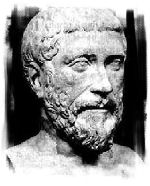 In addition to the theory of the counter-earth, other such notable foundations include the Central Fire and the Initiates, or at least the principle of the Initiates. Let's take a look at great thinker and philosopher. Oh, and don't be surprised if many things seem overtly familiar!
In addition to the theory of the counter-earth, other such notable foundations include the Central Fire and the Initiates, or at least the principle of the Initiates. Let's take a look at great thinker and philosopher. Oh, and don't be surprised if many things seem overtly familiar!
Although much is cited here about Pythagoras and his philosophies, it must be noted that there is not much historical evidence from the pre-Christian era. Information gathered here is based on scattered remnants of writings and much of the following is pure speculation on the part of historians.
Pythagoras is a one of the most obscure figures in history. He was a mystic thinker, a religious reformer and a philosopher. Several journeys are attributed to him, including one to Persia where he is said to have met the Magus Zaratas (a.k.a. Zoroaster/Zarathustra). He is further associated with the Orphics and the revival of the worship of Dionysus.
His father was Mnesarchos, who was a merchant who came from Tyre, and his mother was Pythais, who was a native of Samos, on the western coast of what is now Turkey. There is a story that Mnesarchos brought corn to Samos at a time of famine and was granted citizenship of Samos as a mark of gratitude. Little is known of Pythagoras's childhood. It has been speculated that as a child, Pythagoras spent his early years in Samos but traveled widely with his father. There are accounts of Mnesarchus returning to Tyre with Pythagoras and that he was taught there by the Chaldaeans and the learned men of Syria. It seems that he also visited Italy with his father.
Accounts of his physical appearance are most probably fictitious or speculation, with exception to the description of a striking birthmark which Pythagoras had on his thigh. He was well educated, learning to play the lyre, learning poetry and to recite Homer. There were, among his teachers, three philosophers who were to influence Pythagoras while he was a young man. One of the most important was Pherekydes who many describe as the teacher of Pythagoras. The other two philosophers who were to influence Pythagoras, and to introduce him to mathematical ideas, were Thales and his pupil Anaximander who both lived on Miletus.
It is said that Pythagoras visited Thales in Miletus when he was between 18 and 20 years old. By this time Thales was an old man and, although he created a strong impression on Pythagoras, he probably did not teach him a great deal. However he did contribute to Pythagoras's interest in mathematics and astronomy, and advised him to travel to Egypt to learn more of these subjects. Thales's pupil, Anaximander, lectured on Miletus and Pythagoras attended these lectures. 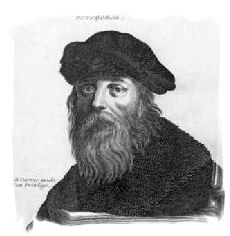 Anaximander certainly was interested in geometry and cosmology and many of his ideas would influence Pythagoras's own views.
Anaximander certainly was interested in geometry and cosmology and many of his ideas would influence Pythagoras's own views.
Pythagoras left Samos to escape the tyranny of Polykrates. A few years after he fled, Pythagoras went to Egypt. There is some evidence to suggest that Pythagoras and Polycrates were friendly at first and it is claimed that Pythagoras went to Egypt with a letter of introduction written by Polycrates. In fact Polycrates had an alliance with Egypt and there were therefore strong links between Samos and Egypt at this time. The accounts of Pythagoras's time in Egypt suggest that he visited many of the temples and took part in many discussions with the priests. According to Porphyry and Pythagoras was refused admission to all the temples except the one at Diospolis where he was accepted into the priesthood after completing the rites necessary for admission.
Cambyses II, the king of Persia, invaded Egypt. Polycrates abandoned his alliance with Egypt and sent 40 ships to join the Persian fleet against the Egyptians. After Cambyses had won the Battle of Pelusium in the Nile Delta and had captured Heliopolis and Memphis, Egyptian resistance collapsed. Pythagoras was taken prisoner and taken to Babylon. Iamblichus writes that Pythagoras:
"… was transported by the followers of Cambyses as a prisoner of war. Whilst he was there he gladly associated with the Magoi … and was instructed in their sacred rites and learnt about a very mystical worship of the gods. He also reached the acme of perfection in arithmetic and music and the other mathematical sciences taught by the Babylonians…
Pythagoras left Babylon and returned to Samos. Polycrates had been killed and Cambyses died either by committing suicide or as the result of an accident. The deaths of these rulers may have been a factor in Pythagoras's return to Samos but it is nowhere explained how Pythagoras obtained his freedom. Darius of Persia had taken control of Samos after Polycrates' death and he would have controlled the island on Pythagoras's return. This conflicts with the accounts of Porphyry and Diogenes Laertius who state that Polycrates was still in control of Samos when Pythagoras returned there.
Pythagoras made a journey to Crete shortly after his return to Samos to study the system of laws there. Back in Samos he founded a school which was called the semicircle. Iamblichus writes in the third century AD that:
"… he formed a school in the city [of Samos], the "semicircle" of Pythagoras, which is known by that name even today, in which the Samians hold political meetings. They do this because they think one should discuss questions about goodness, justice and expediency in this place which was founded by the man who made all these subjects his business. Outside the city he made a cave the private site of his own philosophical teaching, spending most of the night and daytime there and doing research into the uses of mathematics…"
Pythagoras left Samos and went to southern Italy. Iamblichus gives some reasons for him leaving. First he comments on the Samian response to his teaching method, which, according to Iamblichus, used in part as an excuse for Pythagoras to leave Samos:
"… he tried to use his symbolic method of teaching which was similar in all respects to the lessons he had learnt in Egypt. The Samians were not very keen on this method and treated him in a rude and improper manner. … Pythagoras was dragged into all sorts of diplomatic missions by his fellow citizens and forced to participate in public affairs. … He knew that all the philosophers before him had ended their days on foreign soil so he decided to escape all political responsibility, alleging as his excuse, according to some sources, the contempt the Samians had for his teaching method."
The School: the Teachings and the Beliefs
In their ethical practices, the Pythagoreans were famous for their mutual friendship, unselfishness, and honesty.
Though much about Pythagoras is unknown, it is certain, however, that he founded a school, or, rather, a religious philosophical society, for which he drew up a rule of life, and in this rule are said to have been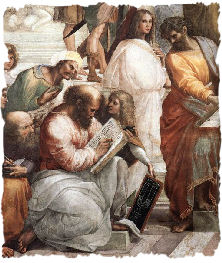 regulations imposing secrecy, a protracted period of silence, celibacy, and various kinds of abstinence. The sect was strict, ascetic and centralized. Members swore an oath of silence and weren't allowed to say anything until they had listened to the teachings of the Master for five years. The authority of the Master was total, his word was not to be questioned in any way whatsoever. All results were attributed to the sect or to the Master, not to their discoverers who remained anonymous. The school was instructed by its founder to devote itself to the cultivation of philosophy, mathematics, music, gymnastics, astronomy and magick, the aim of the organization being primarily ethical. In this picture by Raphael, Pythagoras, the man in the center with the book, is teaching music in The School of Athens.
regulations imposing secrecy, a protracted period of silence, celibacy, and various kinds of abstinence. The sect was strict, ascetic and centralized. Members swore an oath of silence and weren't allowed to say anything until they had listened to the teachings of the Master for five years. The authority of the Master was total, his word was not to be questioned in any way whatsoever. All results were attributed to the sect or to the Master, not to their discoverers who remained anonymous. The school was instructed by its founder to devote itself to the cultivation of philosophy, mathematics, music, gymnastics, astronomy and magick, the aim of the organization being primarily ethical. In this picture by Raphael, Pythagoras, the man in the center with the book, is teaching music in The School of Athens.
Both men and women were permitted to become members of the Society, in fact several later women Pythagoreans became famous philosophers. They were strict vegetarians, and were also prohibited from eating beans since they were thought to house the souls of the dead. They could not wear clothes made of wool; the could not pick up anything that had fallen, or stir a fire with iron. The sect was divided between the akousmatikoi (hearers) and the mathematikoi (learned).
The outer circle of the Society were known as the akousmatikoi, (also seen: akousmatics) who lived in their own houses, only coming to the Society during the day. They were allowed their own possessions and were not required to be vegetarians. The mathematikoi lived permanently with the Society, had no personal possessions and were vegetarians. They were taught by Pythagoras himself and obeyed strict rules.
Hmmmm. Sounds pretty familiar, doesn't it? (Ed. Note: Refer to the Initiates page.)
It is not difficult to relate many of Pythagoras's beliefs, ones he would later impose on the society that he set up in Italy, to the customs that he came across in Egypt. For example the secrecy of the Egyptian priests, their refusal to eat beans, their refusal to wear even cloths made from animal skins, and their striving for purity were all customs that Pythagoras would later adopt.
The main difficulty to overcome: the body and its necessities which subdue man. It is necessary to free oneself from these. The body is a tomb — one must triumph over it, but not lose it. To so so requires that one attain the state of enthusiasm (en- theos). This seems to suggest a connection with the Orphics and their rites, founded on mania, "orgy" — athough the Pythagoreans apparently moderated this somewhat. In this way, one attains a self-sufficient, theoretic life — a life not tied to the necessities of the body, a divine life. Such a man is a wise man, a sophos. The term philosophia, "love of wisdom," is first used in Pythagorean circles.
The beliefs that Pythagoras held were:
- that at its deepest level, reality is mathematical in nature,
- that philosophy can be used for spiritual purification,
- that the soul can rise to union with the divine,
- that certain symbols have a mystical significance, and
- that all brothers of the order should observe strict loyalty and secrecy.
The Pythagoreans trained themselves in the exercise of self-control in the following manner. 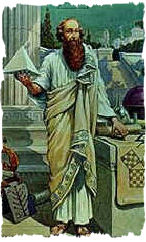 They would have prepared for them everything which is served up at the most brilliant banquets, and would gaze upon it for a considerable time; then, after through mere gazing they had aroused their natural desires with a view to their gratification, they would command the slaves to clear away the tables and would at once depart without having tasted of what had been served.
They would have prepared for them everything which is served up at the most brilliant banquets, and would gaze upon it for a considerable time; then, after through mere gazing they had aroused their natural desires with a view to their gratification, they would command the slaves to clear away the tables and would at once depart without having tasted of what had been served.
Of Pythagoras's actual work nothing is known. His school practiced secrecy and communalism making it hard to distinguish between the work of Pythagoras and that of his followers. Certainly his school made outstanding contributions to mathematics, and it is possible to be fairly certain about some of Pythagoras's mathematical contributions.
The Pythagoreans believed that the universe could be understood in terms of whole numbers. This belief stemmed from observations in music, mathematics and astronomy. For example, they noticed that vibrating strings produce harmonious tones when the ratios of the their lengths are whole numbers. From this first attempt to express the universe in terms of numbers the idea was born that the world could be understood through mathematics, a central concept in the development of mathematics and science.
Pythagorean Cosmotology
Pythagoras also developed a rather sophisticated cosmology. He and his followers believed the earth to be perfectly spherical and that heavenly bodies, likewise perfect spheres, moved as the Earth around a central fire invisible to human eyes, which was not the sun for it also circled this central fire.
There were ten (10) objects circling the central fire which included a counter-earth assumed to be there to account from some eclipses but also because they believed the number ten (10) to be particularly sacred. Pythagoras taught that there was not one principle underlying the sensible universe, but ten (10), and that these were organized in contrasting pairs:
- Limit and Unlimited
- Odd and Even
- One and Plurality
- Right and Left
- Male and Female
- Rest and Motion
- Straight and Crooked
- Light and Darkness
- Good and Evil
- Square and Oblong
This is the first coherent system in which celestial bodies move in circles, an idea that was to survive for two thousand years. It was also stated that heavenly bodies give forth musical sounds "the harmony of the spheres'' as they move in the cosmos, a music which we cannot discern, being used to it from childhood (a sort of background noise); though we would certainly notice if anything went wrong! The Pythagoreans did not believe that music, numbers and cosmos were just related, they believed that music was number and that the cosmos was music.
Hmm. The Pythagorean Table of Opposites also articulates the opposition between male and female starkly.
The Central Fire and the Counter-Earth
The account given by the Pythagoreans of the "harmony of the spheres" is the best illustration of their method. There are, they said, ten heavenly bodies, namely, the heaven of the fixed stars, the five planets, the sun, the moon, the earth, and the counter-earth. 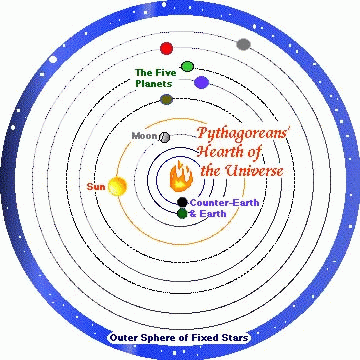 The counter-earth is added because it is necessary to make up the number ten, the perfect number. It is a body under the earth, moving parallel with it, and, since it moves at the same rate of speed, it is invisible to us. The five planets, the sun, the moon, and the earth with its counter-earth, moving from west to east at rates of speed proportionate to the distance of each from the central fire, produce eight tones which give an octave, and , therefore, a harmony.
The counter-earth is added because it is necessary to make up the number ten, the perfect number. It is a body under the earth, moving parallel with it, and, since it moves at the same rate of speed, it is invisible to us. The five planets, the sun, the moon, and the earth with its counter-earth, moving from west to east at rates of speed proportionate to the distance of each from the central fire, produce eight tones which give an octave, and , therefore, a harmony.
The Pythagoreans taught that the planets (including the invisible Counter-Earth on the other side of the Sun), the Moon and the Sun were fixed on great spheres of crystal, rotating around a central fire. Their motions creates the exquisite harmony of the spheres, which ordinary people cannot hear because they are too used to it. The Pythagoreans made no distinction between music, mathematics and magick. Music was found to be based upon subtle mathematical laws, and so was magick. Everything in the universe follows mathematical laws and is created out of the geometrical interactions of the numbers, which are the true basis of reality.
The Pythagoreans believed in the eastern idea that the soul is divine and immortal, and that it does reincarnate after each death. It is imprisoned in our imperfect material bodies as a punishment. The goal for all rational people is to break free from this prison. The only way this can be achieved is by seeing and understanding the true reality. In the tradition of Greek philosophy, the Pythagoreans were more thinkers and mystics than practical mages. They regarded the external use of magick (or mathematics) as filthy, and avoided it at all costs. Instead they turned inwards, studying the secrets of the universe. They did not want to reveal anything to the unworthy people outside the group, preferring to keep silence on the great truth they knew.
Pythagorean philosophy was the prime source of inspiration for Plato and Aristotle; the influence of these philosophers is without question and is immeasurable. Their ideas were adopted by Plato and through him later influenced the Gnostics and the Order of Hermes (and the Technocracy to some extent). The sect were never forgotten, and small groups may have revived its ideas and practices at different times and places. Its ideas seem to have survived with a surprising tenacity.
Passages in Aristotle referring to the Pythagoreans
De coel. ii. 13; 293 a 19. "They say that the whole heaven is limited, the opposite to what those of Italy, called the Pythagoreans, say; for these say that fire is at the centre and that the earth is one of the stars, and that moving in a circle about the centre it produces night and day. And they assume yet another earth opposite this which they call the counter-earth, not seeking reasons and causes for phenomena, but stretching phenomena to meet certain assumptions and opinions of theirs and attempting to arrange them in a system … And farther the Pythagoreans say that the most authoritative part of the All stands guard, because it is specially fitting that it should, and this part is the centre; and this place that the fire occupies, they call the guard of Zeus, as it is called simply the centre, that is, the centre of space and the centre of matter and of nature."
Passages in the Doxographists
Aet. Plac. ii. 29; 360. "Some of the Pythagoreans (according to the Aristotelian account and the statement of Philip the Opuntian) said that an eclipse of the moon takes place, sometimes by the interposition of the earth, sometimes by the interposition of the counter-earth."
![]()
Disclaimer
These pages are not written for any specific home, but rather as informational pages for those not able to get ahold of the books and read them yourself. Opinions and commentaries are strictly my own personal views, therefore, if you don't like what you are reading — then don't. The information in these pages is realistic to what is found within the books. Many sites have added information, assuming the existences of certain products and practices, such as willowbark and agrimony for healing, and travel to earth and back for the collection of goods. I've explored the books, the flora, the fauna, and the beasts, and have compiled from those mentioned, the probabilities of certain practices, and what vegetation mentioned in the books is suitable for healing purposes, as well as given practicalities to other sorts of roleplaying assumptions.